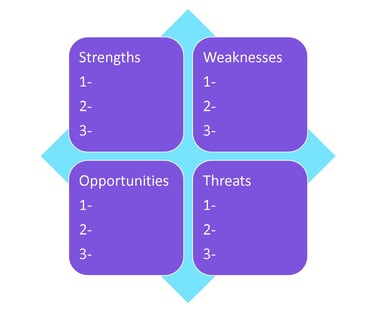On Strengths and Weaknesses
Part II of my series on introspection featuring the world famous SWOT analysis.
INTROSPECTION SERIES


If you've been following my writings so far then you must have noticed a common theme. I keep talking about the importance of knowing yourself. In "Sad, Glad, Mad, and Afraid" I talked about knowing your values, the foundation for what drives your behavior, and in "On People Pleasing" I talk about knowing your needs and limitations.
Today's post is about the latter. More specifically, it's about how to find your needs and limitations.
I want you to try and think of yourself as a business endeavor. In other words, you are the entity that you are investing your resources in and are responsible for managing.
Starting from that point, let's talk about one of the most powerful tools in business development: the SWOT (Strengths, Weaknesses, Opportunities, and Threats) analysis (also known as the SWOT matrix).
"Know your strengths and weaknesses, find opportunities, and identify threats."
To better identify your needs and limitations within any context, you need to be able to identify your abilities, and the SWOT analysis is one of the simplest and most effective tools for doing exactly that.
For a general analysis of your current situation, take a piece of paper or open a new document on your device. Split your page into four quadrants and label each quadrant: Top left is strengths, top right is weaknesses, bottom left is opportunities, and bottom right is threats.


Now that you have the matrix prepared, ask yourself the following questions and fill it out accordingly:
1- What do you do well?
2- What is your competitive edge?
3- What internal strengths do you have (skills, knowledge, network, reputation, etc.)?
4- What external strengths do you have (resources, technology, etc.)?
5- What skills training do you have?
6- What are your weaknesses?
7- What are the weaknesses in your action plan?
8- What are the current trends?
9- Can you innovate?
10- What external factors put you at risk?
When you've answered these questions and filled out the matrix, you will have taken inventory of your abilities and limitations and gotten to know yourself a little bit better in the process.
"Build on strengths, eliminate weaknesses, create opportunities, and mitigate threats."
After you've taken inventory of your current state of affairs, it is time to think about how to improve it. Identifying abilities and limitations is only one part of the process. The next part aims to grow your strengths, minimize your weaknesses, capitalize on opportunities, and plan for threats.
To do that, take the time to answer the following questions:
1- Can you do more or reach more?
2- How can you build on your strengths?
3- Are you making the best use of your skills and training?
4- Are you making the best use of your resources?
5- Can you improve your strengths?
6- What other strengths can you be using more effectively?
7- What processes or strategies can you develop to minimize the effect of your weaknesses?
8- Can you change one or two components of your plan to improve it?
9- Can you use current trends to your advantage?
10- Are there new opportunities that you could consider?
11- Are there any upcoming changes that might have a positive effect on your plan?
12- What is your strategy for risk management?
13- How will you build resilience and navigate risk?
14- Are you in the right place?
Once you've taken the time to answer these questions until you are satisfied, your context and circumstances will have changed and become the basis for your next SWOT analysis. Introspection is an ongoing and repeating process. Regularly checking in with yourself, taking assessments, and making adjustments is what allows you the agility to improve and grow largely undeterred by external factors.
